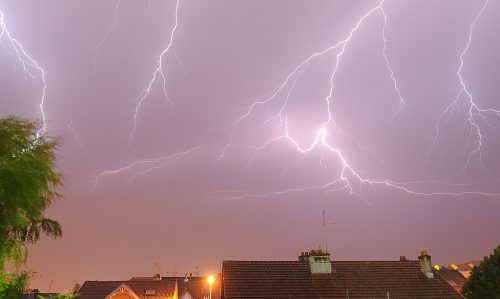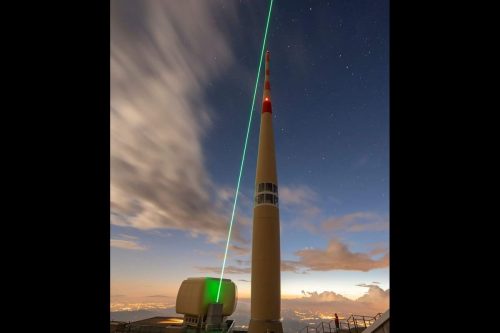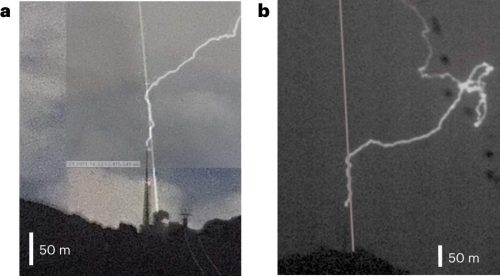Säntis, Switzerland —(Map)
Scientists in Switzerland have used lasers to change the path of a lightning strike. The experiment suggests that in the future, lasers might be useful for protecting large buildings from lightning.
The experiment was carried out on Säntis mountain in Switzerland, near a radio and TV tower that’s hit by lightning about 100 times a year. Using a special laser, the researchers were able to guide the lightning strike.
Lightning is a huge burst of electricity that jumps between two points – often between the clouds and the ground.
Lightning can be extremely powerful and cause serious problems on the ground. Lightning strikes can cause fires, destroy buildings, and kill people. The damage from lightning costs billions of dollars every year. In the US, lightning strikes killed close to 450 people between 2006 and 2021.

(Source: Thomas Bresson [CC BY 3.0], via Wikimedia Commons.)
Scientists have been trying to find a way to protect buildings from lightning for a long time.
Currently, the best way to protect buildings from lightning is by putting metal rods on the buildings. These rods are connected to the ground. The lightning is attracted to the rods, which safely guide the electricity into the ground.
But lightning rods can only protect a small area. If a building is very large, it needs a lot of lightning rods. But some buildings – such as airports – are so large that it’s difficult to protect the whole building using lightning rods.
Another idea is to use lasers to guide lightning. The idea of using lasers to guide lightning isn’t new. Scientists have been working on the idea for over 20 years. They have successfully guided lightning with lasers inside a laboratory.

(Source: Houard, A., Walch, P., Produit, T. et al. [CC BY 4.0], Nature.)
But until recently, scientists haven’t been able to guide lightning with lasers outside. That changed in the summer of 2021. Using a powerful laser that can fire about 1,000 times a second, scientists in Switzerland were able to guide lightning bolts for 164 feet (50 meters).
The heat from the laser creates a path of air that is less dense (thick) than the air around it. The path also has a special charge. The lightning can follow this path almost as if it were a lightning rod.
During six hours of tests, the lasers were able to change the path of the lightning four different times.

(Source: Houard, A., Walch, P., Produit, T. et al. [CC BY 4.0], Nature.)
The scientists say that it was the speed of the laser that allowed them to guide the lightning. In the past, experiments with lasers that fired more slowly didn’t work.
Scientist Matteo Clerici wasn’t part of the experiment, but he also studies guiding electricity. He said, “The fact that they managed to do it in an outdoor environment is a very big step.”
But despite the progress, the laser still didn’t guide the lightning as far as the scientists would like. To protect buildings from most lightning, lasers will have to guide the lightning for a much longer distance.
The laser is also very expensive. The scientists say it cost about $2 billion. It will probably take 10 or more years before a laser like this is truly able to protect large buildings.
😕
This map has not been loaded because of your cookie choices. To view the content, you can accept 'Non-necessary' cookies.
